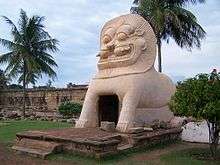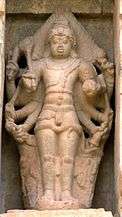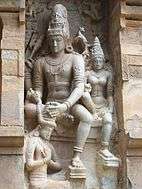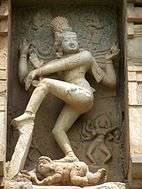Brihadeeswarar Temple, Gangaikonda Cholapuram
| Brihadeeswarar Temple | |
|---|---|
|
| |
 Brihadeeswarar Temple Location in Tamil Nadu | |
| Name | |
| Other names | Tanjai Periya Kovil |
| Geography | |
| Coordinates | 11°12′22″N 79°27′05″E / 11.20611°N 79.45139°ECoordinates: 11°12′22″N 79°27′05″E / 11.20611°N 79.45139°E |
| Country | India |
| State | Tamil Nadu |
| District | tanjore |
| Culture | |
| Primary deity | Shiva |
| Important festivals | Maha Shivaratri |
| Architecture | |
| Architectural styles | Dravidian Architecture |
| History and governance | |
| Date built | 11th century AD |
| Creator | Rajendra Chola I |
Brihadeshwara Temple (also called Gangaikonda Cholapuram temple and Gangaikondacholeeswaram) is a Hindu temple dedicated to Shiva located in Gangaikonda Cholapuram, Ariyalur district, in the South Indian state of Tamil Nadu. It is one of the largest temples in India and is an example of Dravidian architecture built by the Chola dynasty. It was built by Rajendra Chola I and completed in 1035 AD.
In modern times, the temple stands amidst dilapidated walls. The vimanam (temple tower) is 55 m (180 ft) high and modelled similar to the Brihadeeswarar Temple at Thanjavur. The temple is one of the most visited tourist attractions in Tamil Nadu.
The temple is open from 6 am - 12:30 pm and 4:30 - 8:00 pm on all days. Four daily rituals and many yearly festivals are held at the temple, of which the Shivarathri during the Tamil month of Masi (February - March), Aipassi Pournami during Aipassi (October - November) and Thiruvadirai during Margazhi (December - January) being the most prominent. The temple is declared as a heritage monument and administered by the Archaeological Survey of India as a protected monument. The temple is declared a CE UNESCO World Heritage Site, along with the Brihadeeswara Temple at Thanjavur and Airavatesvara temple at Darasuram that are referred as the Great Living Chola Temples.
Architecture
Brihadeeswara temple is built on an elevated structure with the courtyard measuring 560 ft (170 m) by 320 ft (98 m). The presiding deity, Brihadeeswarar, in the form of Lingam is housed in the central shrine. The principal section of the court measures 104 m (341 ft) by 30.5 m (100 ft) with an east-west axis.[1] The sanctum measures 100 sq ft (9.3 m2) and is approached through columned Mukhamandapa (prayer hall) and an Ardhamandapa (hall of sacrifice). The sanctum is guarded by Dvarapalas, the guardian deities, each 6 ft (1.8 m) tall. The vimanam (temple tower) is 55 m (180 ft) high, which is 3 m (9.8 ft) smaller than the Thanjavur temple. Compared to the Thanjavur temple, which has straight contours, this temple has concave contours, divided into eight zones.[1] Experts believe that the decision to make it smaller than the Thanjavur temple, built by Raja Raja Chola I (984 - 1014 CE), the father of Rajendra I is considering the father - son hereditary aspect and also to treat this as the feminine equivalent of the Thanjavur temple. The image of the Lingam (an iconic representation of Shiva) is 4 m (13 ft) tall and is the largest for any Shiva temple.[2] There is an image of Nandi located axially 200 m (660 ft) facing the sanctum, which is constructed in such a way that it reflects Sun light on to the sanctum. The bull is made of stucco and fallen stones.[3] A stone named Chandrakanta is laid in the sanctum that keeps the sanctum cool during summer and warm during summer. The image of Periyanagai is housed in a south facing shrine and is 9.5 ft (2.9 m) tall.[4] There are five shrines around the sanctum and a Lion well, which is believed to be an addition during the 19th century. There are around 50 sculptural relief around the walls of the sanctum, three of which of Nataraja, Saraswathi and Shiva garlanding a devotee being the most prominent. Some believe that the devotee is Chandesa (one of the 63 Nayanmars), while others consider it that of king Rajendra himself. There are other niches around the walls of the temple depicting various forms of Shiva, Durga and Vishnu. There are many bronze statues in the temple depicting Chola art of the 11 century, with the one of Subramanya being the most recognised.[5]
History
The temple was constructed in 1035 AD by Rajendra Chola I (1014-44 CE), the son of the famous Chola king Raja Raja Chola I, who built the Brihadeeswarar Temple at Thanjavur.[3] Some experts believe that the temple was built during 1020, during the 6th regnal year, but inscriptions indicate the 20th regnal year, which is 1035 AD. Rajendra wanted to emulate the temple built by his father after his victory in the Ganges over the Pala Dynasty. He assumed the name of Gangaikonda Cholan, meaning the one who conquered the Ganges. He established Gangaikonda Cholapuram as his capital from the medieval Chola capital of Thanjavur, which would go on to become the capital for the next 250 years.[6] It is believed from the inscriptions and the excavations made during the 1980s that it was a planned city with palaces and fortified walls, with the temple in the centre. It is believed that Rajendra redirected all the endowments of the Brihadeeswar temple at Thanjavur to this temple. Rajendra is believed to have involved the same craftsmen used by his father and transferred them from Thanjavur.[3] Most of the Chola kings after Rajendra I had their coronation at Gangaikonda Cholapuram. It is believed that Kulothunga Chola I, the successor of Rajendra built fortifications around the city. The Pandyas overpowered the Cholas during the later part of 13th century and to avenge their previous defeats, they destroyed the city and palaces, leaving just the temple and its surroundings.[7]
Culture

Gangaikondacholpuram and the temple find mention in many of the contemporary works of the period like Muvar Ula and Kalingathuparani. Scholars like Vasanthi believe that the 11th century Tamil poet Kambar's description of Ayodhya was based on the streets and city structure of Gangaikonda Cholapuram. Similar correlation is derived based on the works of Sekkizhar in Periya Puranam. Muvar Ula, a treatise on the Cheras, Cholas and Pandyas, gives vivid account of the city and the temple.[7] Like the Thanjavur temple, this temple is also believed to have emerged as a centre of social, economical and political activities. Cultural activities like music, dance and art in the form of bronzes were encouraged and staged in the temple.[8]
Experts believe that the Dravidian architecture attained its supreme form of expression in the Brihadeeswarar Temple at Thanjavur and at this temple.[1] The temple is declared as a heritage monument and administered by the Archaeological Survey of India as a protected monument. The temple is one of the most visited tourist attractions in Tamil Nadu.[9] The temple is declared a CE UNESCO World Heritage Site, along with the Brihadeeswara Temple at Thanjavur and Airavatesvara temple at Darasuram that are referred as the Great Living Chola Temples.[10] The temple was added to the list of Great Living Chola Temples in the year 2004. All of the three temples were built by the Cholas between the 10th and 12th centuries CE and have a lot of similarities.[11][12] The ASI made additions to the shopping and visitor attraction offices in the temple in 2009 that included a museum, restaurant, shops and restrooms under the aegis of the Hindu Religious and Endowment Board of the Government of Tamil Nadu.[13] The temples are classified as "Great Living Chola temples" as the temples are alive in cultural aspects and worship practises in modern times.[14] The millennium celebrations of the coronation of the Rajendra Chola was celebrated for two days during July 2014 in the temple.[15]
Festivals and worship practises
Though it is administered by the Archaeological Survey of India as a monument, worship practises are followed similar to other Shiva temples in Tamil Nadu. The temple follows Saivite tradition and the temple priests perform the pooja (rituals) during festivals and on a daily basis. The temple rituals are performed four times a day: Kalasanthi at 8:30 a.m., Uchikalam at 12:30 p.m., Sayarakshai at 6:00 p.m., and Arthajamam between 7:30 - 8:00 p.m. Each ritual has three steps: alangaram (decoration), neivethanam (food offering) and deepa aradanai (waving of lamps) for both Brihadeeswarar and Periya Nayagi. There are weekly, monthly and fortnightly rituals performed in the temple. The temple is open from 6 am - 12:30 pm and 4-9:00 pm on all days. The temple has many festivals in its calendar, with the Shivarathri during the Tamil month of Masi (February - March), Aipassi Pournami during Aipassi (October - November) and Thiruvadirai during Margazhi (December - January) being the most prominent.[4]
See also
References
- 1 2 3 Roma Chatterjee, ed. (2016). India Art and Architecture in ancient and medieval periods. New Delhi: Publications Division, Ministry of Information and Broadcasting, Government of India. p. 33. ISBN 978-81-230-2080-8.
- ↑ Dobbie, Alien (2006). India: The Elephant's Blessing. Melrose Press. pp. 74–77. ISBN 9781905226856.
- 1 2 3 Dehejia, Vidya (2013). Art of the Imperial Cholas. Columbia University Press. pp. 79–81. ISBN 9780231515245.
- 1 2 "Sri Bragadeeswarar temple". Dinamalar. 2014. Retrieved 31 May 2014.
- ↑ Menon, Indira (2013). Rhythms in Stone, the temples of South India. Ambi Knowledge Resource. p. 60. ISBN 9788190359139.
- ↑ Melton, J. Gordon (2014). Faiths Across Time: 5,000 Years of Religious History [4 Volumes]: 5,000 Years of Religious History. ABC-CLIO. p. 674. ISBN 9781610690263.
- 1 2 S., Vasanthi (2009). "Excavation at Gangaikonda Cholapuram, the imperial capital of Rajendra Chola, and its significance". In Kulke, Hermann; K., Kesavapany; Sakhuja, Vijay. Nagapattinam to Suvarnadwip: Reflections on the Chola Naval Expeditions to Southeast Asia. Singapore: Institute of south-east Asian Studies. pp. 96–100. ISBN 978-981-230-938-9.
- ↑ Vipul, Singh (2009). Longman Vistas 7. Pearson Education India. pp. 14–15. ISBN 9788131729090.
- ↑ Gopal, Madan (1990). K.S. Gautam, ed. India through the ages. Publication Division, Ministry of Information and Broadcasting, Government of India. p. 185.
- ↑ "Great Living Chola Temples". UNESCO World Heritage Centre. 2004. Retrieved 28 November 2015.
- ↑ Ayyar, P.V. Jagadisa (1993). South Indian Shrines. New Delhi: Asian Educational Services. p. 316. ISBN 81-206-0151-3.
- ↑ T., Ramakrishnan (7 July 2004). "World Heritage Site status for Airavatesvara Temple". The Hindu. Retrieved 28 November 2015.
- ↑ "Gangaikondacholapuram decked up to welcome tourists". Ariyalur: The Hindu. 28 December 2009. Retrieved 28 November 2015.
- ↑ Srinivasan, Pankaja (4 June 2012). "Inside the Chola Temple". Coimbatore: The Hindu. Retrieved 28 November 2015.
- ↑ M., Balaganessin (25 July 2014). "Tributes paid to Rajendra Chola". Ariyalur: The Hindu. Retrieved 28 November 2015.
External links
| Wikimedia Commons has media related to Gangaikonda Cholapuram Temple. |




